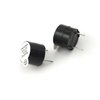Sir . . . . . . . . B e e e e e e e e e g KIM . . . . . 98 . . .99 . . .100 !
LONG see . . . .no
TIME !
So I use your provided HOT link and it then sends me to Digi Key where I see a Parallax unit . . . .e w w w . . . it be velly-velly pricey . . . .9 + Amellican dollah . .. . . .Chinee onlee $1.32. . . . .but you waitee 3 week-1 monthee !
Their down load gives me this circuity . . . . now what I am seeing there is an Electret condenser microphone element and its internal FET circuitry is receiving its power via R5 and the VCC supply and its metalized mylar film capacitor diaphragm is receiving its polarizing voltages electrostatic charge from its adjunct mounted ferroelectric polar ring.
Then, DC isolated, audio output coupling is being made into the Q1 discrete audio preamp / DC level shifter via C1 poly/ cap.
( I see 3 vias on this side of the board so Q1 and some of its associative components must be on the other side of the board.)
As per your addition of another / other sensor mikes you might try the
YELLOW mark up area and keep the duplicate / equivalent R5 and C1 elements, as is needed for each mike, close on board.
Then you remote in the mike (s) wiring . . . . . .( you did not specify distance ) . . . . but if being distant, their lines might need mesh shielded wire . . . . as per the 3rd mikes example.
SCHEMATIC MARK-UP . . . . .
 SIDE THOUGHT . . . .
SIDE THOUGHT . . . . from above
I can't quite fully "apprehend" the no-no need of non woven cloth aspect, which is assuredly JUST being relevant to the precise sound hole entry on the front center of the mike.
I can see the non use of a particular plastic family of threads. (Electrostatics)
I can see the avoidance of criss- cross, x to y plane interweaving of individual threads.
That then just leaves either a x-y precise micro- micro- spacing apart of all threads and then cross binding by adhesive or thermal bonding . . . .or else. . . .
The cloth is made in a porous matted construction . . .akin to thin black felt matting .
FINAL THOUGHT . . . . .
I see that you are still
SPORTING your
CHARTREUSE sl e e e e e e e e e e e e ng bikini . . . . .
MAN ! ! ! I'll bet that if you were to get that thing all wound up with your two "projectiles" inside, that you could hit the broadside center of distant barn . . . . . . .
"SPLA T T T " . . .
"SPLA T T T " . . .
73's de Edd . . . . .
WHYIZZITALWAYSDAT . . . .Clearly stated, concise instructions will consistently produce multiple interpretations.
.




